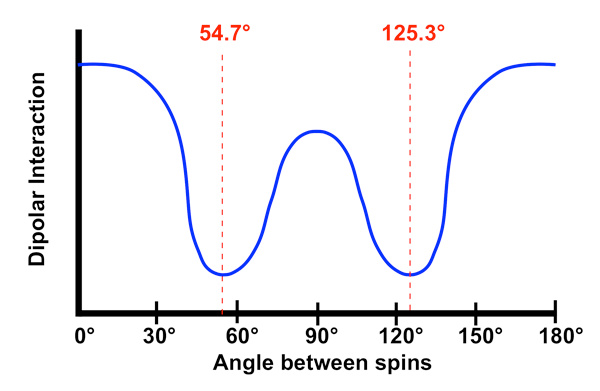|
When the arrangement of the two nuclei approach the magic angle, the effect of Bμz is minimized and the T2 value is increased. As shown in the graph (left), this angular dependence changes gradually over a wide range of angles rather than dropping off precipitously at the magic angle. The dipolar interaction does not return to normal at 90° because of the combined effects of the "dips" at 54.7° and 125.3°.
|
|
A basic science application of this phenomenon is known as Magic angle spinning (MAS), a technique used in solid-state MR spectroscopy laboratories. The sample is placed in an air-turbine device angled 54.7° with respect to the main magnetic field and spun at rates up to 70 kHz. The angulation and spinning averages out the dipole-dipole couplings to zero allowing better appreciation of features of the NMR spectrum (such as secondary quadripolar couplings and chemical shift anisotropies) for determining molecular structures.
|
Advanced Discussion (show/hide)»
Although mostly reported in regard to tendons, the magic angle phenomenon can also be seen in peripheral nerves that contain longitudinally-oriented type I collagen fibers in the epineurium. Nerves, however, possess several imaging differences compared to tendons.
First, the magic angle effects of T2 prolongation in peripheral nerves can be appreciated on STIR or T2-weighted SE sequences (even with TE's longer than 60 ms). Secondly, the change in signal may occur more gradually and over a wider range of orientations in peripheral nerves compared to tendons. This different imaging behavior likely relates to the fact that the peripheral nerves contain substantial material besides collagen and with average baseline T2 values higher than tendons.
Finally, it should be noted that the magic angle effects will occur in a different location and plane of imaging if MRI is performed in a vertical bore scanner (having a different orientation of Bo with respect to the regional anatomy).
Bydder M, Rahal A, Fullerton GD, Bydder GM. The magic angle effect: a source of artifact, determinant of image contrast, and technique for imaging. J Magn Reson Imaging 2007;25:290-300.
Chappell KE, Robson MD, Stonebridge-Foster A, et al. Magic angle effects in MR neurography. AJNR 2004;25:431-440.
Erickson SJ, Prost RW, Timins ME. The "magic angle" effect: background physics and clinical relevance. Radiology 1993;188:23-25.
Fullerton GD, Rahal A. Collagen structure: the molecular source of the tendon magic angle effect. J Mag Reson Imaging 2007;25:345-361.
Jiang YJ, Harper JK. An explanation of magic angle spinning NMR experiments in the time domain. Concepts Magn Reson Part A, 2009; 34A:249-263.
Peh WCG, Chan JHM. The magic angle phenomenon in tendons: effect of varying the MR echo time. Br J Radiol 1998; 71:31-36.
Physicsinsights.org. The field of a small magnetic dipole. 2007. (A short and straightforward derivation of the Bμz equation given above).
Can you explain a little more about the dipole-dipole interaction? I still don't quite understand.
Why is T1 longer than T2?





